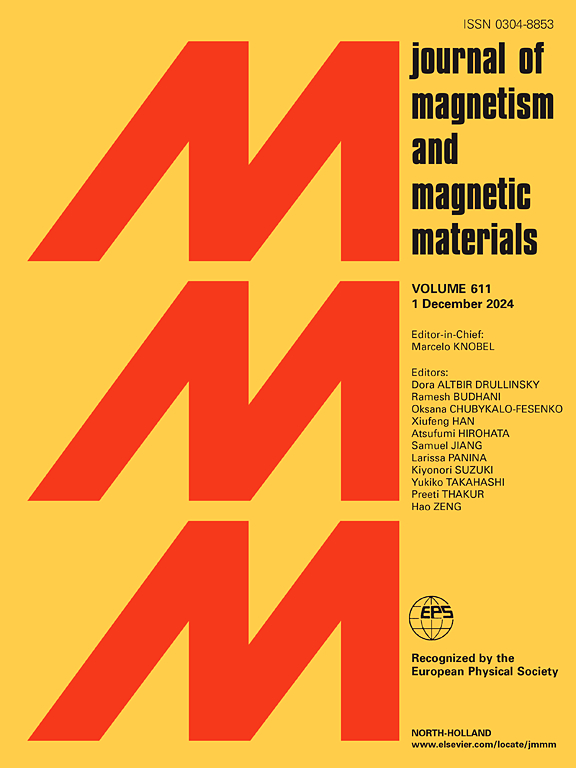Unveiling the robustness of half-metallicity under strain effects of CoVYZ (Z = Si, Ge, Sn) alloys
IF 2.5
3区 材料科学
Q3 MATERIALS SCIENCE, MULTIDISCIPLINARY
引用次数: 0
Abstract
Based on density functional theory computations, a systematic analysis has been conducted to elucidate the physical attributes of CoVYZ (Z = Si, Ge, Sn) alloys. To treat the exchange and correlation effects, generalized gradient approximation has been incorporated using WIEN2k package. The structural characteristics assure that CoVYZ alloys are comparatively stable in magnetic phase and electronic properties reveal that these alloys are half-metallic. The band character spectra of CoVYZ alloys signify that the Fermi level is predominantly influenced by the dt2g bands of Co-atom. The calculated values of total magnetic moment found to be µtotal= 3.0 pointing the Slater-Pauling rule, ( In CoVYZ (Z = Si, Sn) alloys, Co exhibits ferrimagnetic coupling under specific strains: +1% to + 5 % for CoVYSi and at + 1 % for CoVYSn. At negative strains, a shift from antiferromagnetism to ferrimagnetism occurs with respect to the V atom: at −5% for Si, −7% for Ge and −10 % for Sn. The effect of uniform strain specifically on the electronic and magnetic characteristics revealed that half-metallicity sustain upto expansion (+6%@ ao) and upto contraction (−13 %@ ao) distinctly. The CoVYSn alloy found most robust, rendering its suitability for spintronic applications under harsh environment.

揭示了CoVYZ (Z = Si, Ge, Sn)合金半金属性在应变效应下的鲁棒性
基于密度泛函理论计算,对CoVYZ (Z = Si, Ge, Sn)合金的物理性质进行了系统分析。为了处理交换效应和相关效应,使用WIEN2k包引入了广义梯度近似。CoVYZ合金具有相对稳定的磁相结构和半金属性质。CoVYZ合金的能带特征谱表明,费米能级主要受co原子dt2g带的影响。总磁矩计算值为µtotal= 3.0 μB/f。u,指向Slater-Pauling规则,(MSPR=Nv-24)μB。在CoVYZ (Z = Si, Sn)合金中,Co在特定应变下表现为铁磁耦合:CoVYSi为+1% ~ + 5%,CoVYSn为+1%。在负应变下,V原子从反铁磁性转变为铁磁性:Si为- 5%,Ge为- 7%,Sn为- 10%。均匀应变对电子和磁特性的影响表明,半金属丰度明显维持在膨胀(+6%@ ao)和收缩(- 13% @ ao)之间。CoVYSn合金最坚固,使其适用于恶劣环境下的自旋电子应用。
本文章由计算机程序翻译,如有差异,请以英文原文为准。
求助全文
约1分钟内获得全文
求助全文
来源期刊

Journal of Magnetism and Magnetic Materials
物理-材料科学:综合
CiteScore
5.30
自引率
11.10%
发文量
1149
审稿时长
59 days
期刊介绍:
The Journal of Magnetism and Magnetic Materials provides an important forum for the disclosure and discussion of original contributions covering the whole spectrum of topics, from basic magnetism to the technology and applications of magnetic materials. The journal encourages greater interaction between the basic and applied sub-disciplines of magnetism with comprehensive review articles, in addition to full-length contributions. In addition, other categories of contributions are welcome, including Critical Focused issues, Current Perspectives and Outreach to the General Public.
Main Categories:
Full-length articles:
Technically original research documents that report results of value to the communities that comprise the journal audience. The link between chemical, structural and microstructural properties on the one hand and magnetic properties on the other hand are encouraged.
In addition to general topics covering all areas of magnetism and magnetic materials, the full-length articles also include three sub-sections, focusing on Nanomagnetism, Spintronics and Applications.
The sub-section on Nanomagnetism contains articles on magnetic nanoparticles, nanowires, thin films, 2D materials and other nanoscale magnetic materials and their applications.
The sub-section on Spintronics contains articles on magnetoresistance, magnetoimpedance, magneto-optical phenomena, Micro-Electro-Mechanical Systems (MEMS), and other topics related to spin current control and magneto-transport phenomena. The sub-section on Applications display papers that focus on applications of magnetic materials. The applications need to show a connection to magnetism.
Review articles:
Review articles organize, clarify, and summarize existing major works in the areas covered by the Journal and provide comprehensive citations to the full spectrum of relevant literature.
 求助内容:
求助内容: 应助结果提醒方式:
应助结果提醒方式:


